Regeneration Effect of a New Bio-Based Warm-Mix Rejuvenator on Performance and Micro-Morphology of Aged Asphalt
Abstract
1. Introduction
2. Materials and Methods
2.1. Materials
2.1.1. Warm-Mix Rejuvenator
2.1.2. Aged Asphalt and Its Rejuvenation
2.2. Experimental Methods
2.2.1. Conventional Physical Tests
2.2.2. Temperature Sweep Test
2.2.3. Multiple Stress Creep Recovery (MSCR) Test
2.2.4. Force–Ductility Test (FDT)
2.2.5. Fourier Transform Infrared Spectroscopy (FTIR) Test
2.2.6. Atomic Force Microscope (AFM) Test
3. Results
3.1. Conventional Physical Properties
3.2. Rheological Properties
3.2.1. Temperature Sweep Test Results
3.2.2. MSCR Test Results
3.2.3. Force Ductility Test (FDT) Results
3.3. Micro-Morphology Analysis Based on AFM
3.3.1. Two-Dimensional (2D) Bee-like Structures Analysis
3.3.2. Three-Dimensional (3D) Micro-Morphology Analysis
3.4. FTIR Analysis Results
4. Conclusions
- (1)
- The incorporation of BWR into aged asphalt can improve the penetration and ductility values and reduce the softening point and viscosity values. When the content of BWR was 7.5%, the conventional physical properties of aged asphalt can be completely restored to the level of virgin asphalt.
- (2)
- Aged asphalt showed better high-temperature rutting resistance with higher G*/sinδ and R values and a lower Jnr value than virgin asphalt, while lower f, EV, and RT/V values indicate that the low-temperature performance of aged asphalt was poorer. The addition of BWR showed a great improvement in low-temperature performance of aged asphalt and a negative effect on high-temperature performance.
- (3)
- The area parameters of 2D bee-like structures and the roughness parameters of the 3D micro-morphology of asphalt were increased after aging, while these parameters could decrease to the level of virgin asphalt after adding BWR with an appropriate dosage, indicating that BWR has a good regeneration effect on the micro-morphology of aged asphalt. In comparison with 2D area parameters, 3D roughness parameters were more accurate in evaluating the variation in micro-morphology of aged asphalt after regeneration.
- (4)
- There was no new functional groups that appeared after the regeneration of aged asphalt, indicating that BWR and ZJ-WR mainly regenerate aged asphalt through physical dilution. Aged asphalt showed lower AS=O and AC=O values and a higher AC-H value after regenerating by BWR and ZJ-WR, and AS=O and AC-H values were more appropriate for the restoration evaluation of aged asphalt than the AC=O value.
- (5)
- Compared with ZJ-WR, BWR has a better regeneration effect on road performance and the micro-morphology of aged asphalt, and the properties of 7.5%BWR are closest to the level of virgin asphalt.
Author Contributions
Funding
Institutional Review Board Statement
Informed Consent Statement
Data Availability Statement
Acknowledgments
Conflicts of Interest
References
- Li, N.; Zhan, H.; Yu, X.; Tang, W.; Xue, Q.L. Investigation of the aging behavior of cellulose fiber in reclaimed asphalt pavement. Constr. Build. Mater. 2021, 271, 121559. [Google Scholar] [CrossRef]
- Gao, J.; Yang, J.G.; Di, Y.; Jiang, Y.; Ruan, K.G.; Tao, W.J.; Sun, C.; Luo, L.H. Reducing the variability of multi-source reclaimed asphalt pavement materials: A practice in China. Constr. Build. Mater. 2021, 278, 122389. [Google Scholar] [CrossRef]
- Omrani, M.A.; Modarres, A. Emulsified cold recycled mixtures using cement kiln dust and coal waste ash-mechanical-environmental impacts. J. Cleaner Prod. 2018, 199, 101–111. [Google Scholar] [CrossRef]
- Ding, Y.J.; Huang, B.S.; Shu, X. Characterizing blending efficiency of plant produced asphalt paving mixtures containing high RAP. Constr. Build. Mater. 2016, 126, 172–178. [Google Scholar] [CrossRef]
- Ding, Y.J.; Huang, B.S.; Shu, X. Blending efficiency evaluation of plant asphalt mixtures using fluorescence microscopy. Constr. Build. Mater. 2018, 161, 461–467. [Google Scholar] [CrossRef]
- Guo, N.S.; You, Z.P.; Tan, Y.Q.; Zhao, Y.H. Performance evaluation of warm mix asphalt containing reclaimed asphalt mixtures. Int. J. Pavement Eng. 2016, 18, 981–989. [Google Scholar] [CrossRef]
- Xie, Z.X.; Tran, N.; Julian, G.; Taylor, A.; Blackburn, L.D. Performance of asphalt mixtures with high recycled contents using rejuvenators and warm-mix additive: Field and lab experiments. J. Mater. Civil. Eng. 2017, 29, 04017190.1–04017190.9. [Google Scholar] [CrossRef]
- Cuciniello, G.; Mallegni, N.; Cappello, M.; Filippi, S.; Leandri, P.; Polacco, G.; Losa, M. Classification and selection of exhausted oils for rejuvenating bituminous blends. Constr. Build. Mater. 2021, 278, 122387. [Google Scholar] [CrossRef]
- Tao, Z.H.; Shen, S.H.; Yu, H.Y.; Sun, Y.; Zou, Y.C. Rejuvenating aged asphalt using surfactant-foaming warm recycling technology. Constr. Build. Mater. 2023, 384, 131297. [Google Scholar] [CrossRef]
- Zadshir, M.; Oldham, D.J.; Hosseinnezhad, S.; Fini, E.H. Investigating bio-rejuvenation mechanisms in asphalt binder via laboratory experiments and molecular dynamics Simulation. Constr. Build. Mater. 2018, 190, 392–402. [Google Scholar] [CrossRef]
- Llin, S.O.; Makarova, V.V. Bio-oil: Production, modification, and application. Chem. Technol. Fuels Oils 2022, 58, 29–44. [Google Scholar]
- Yadykova, A.Y.; Llin, S.O. Compatibility and rheology of bio-oil blends with light and heavy crude oils. Fuel 2022, 314, 122761. [Google Scholar] [CrossRef]
- Zadshir, M.; Hosseinnezhad, S.; Fini, E.H. Deagglomeration of oxidized asphaltenes as a measure of true rejuvenation for severely aged asphalt binder. Constr. Build. Mater. 2019, 209, 416–424. [Google Scholar] [CrossRef]
- Fini, E.H.; Hosseinnezhad, S.; Oldham, D.J.; Chailleux, E.; Gaudefroy, V. Source dependency of rheological and surface characteristics of bio-modified asphalts. Road Mater. Pavement Des. 2017, 18, 408–424. [Google Scholar] [CrossRef]
- Pahlavan, F.; Hung, A.M.; Zadshir, M.; Hosseinnezhad, S.; Fini, E.H. Alteration of π-electron distribution to induce deagglomeration in oxidized polar aromatics and asphaltenes in an aged asphalt binder. ACS Sustain. Chem. Eng. 2018, 6, 6554–6569. [Google Scholar] [CrossRef]
- Suo, Z.; Nie, L.; Xiang, F.R.; Bao, X. The effect of waste plant oil on the composition and micro-morphological properties of old asphalt composition. Buildings 2021, 11, 407. [Google Scholar] [CrossRef]
- Zhang, D.; Chen, M.Z.; Wu, S.P.; Liu, J.X.; Amirkhanian, S.; Morreale, M. Analysis of the relationships between waste cooking oil qualities and rejuvenated asphalt properties. Materials 2017, 10, 508. [Google Scholar] [CrossRef]
- Fang, Y.; Zhang, Z.Q.; Yang, J.H.; Li, X.J. Performance characterization of biorecycled asphalt and gray correlation analysis between its components and macroproperties. J. Mater. Civil. Eng. 2022, 34, 04021490. [Google Scholar] [CrossRef]
- Sengoz, B.; Oylumluoglu, J. Utilization of recycled asphalt concrete with different warm mix asphalt additives prepared with different penetration grades bitumen. Constr. Build. Mater. 2013, 45, 173–183. [Google Scholar] [CrossRef]
- Song, W.M.; Huang, B.S.; Shu, X. Influence of warm-mix asphalt technology and rejuvenator on performance of asphalt mixtures containing 50% reclaimed asphalt pavement. J. Clean. Prod. 2018, 192, 191–198. [Google Scholar] [CrossRef]
- Hettiarachchi, C.; Hou, X.D.; Wang, J.Y.; Xiao, F.P. A comprehensive review on the utilization of reclaimed asphalt material with warm mix asphalt technology. Constr. Build. Mater. 2019, 227, 117096. [Google Scholar] [CrossRef]
- Guo, N.S.; You, Z.P.; Zhao, Y.H.; Tan, Y.Q.; Diab, A. Laboratory performance of warm mix asphalt containing recycled asphalt mixtures. Constr. Build. Mater. 2014, 64, 141–149. [Google Scholar] [CrossRef]
- Nejad, F.M.; Azarhoosh, A.; Hamedi, G.H.; Roshani, H. Rutting performance prediction of warm mix asphalt containing reclaimed asphalt pavements. Road Mater. Pavement Des. 2014, 15, 207–219. [Google Scholar] [CrossRef]
- Dong, F.Q.; Yu, X.; Xu, B.; Wang, T.Y. Comparison of high temperature performance and microstructure for foamed WMA and HMA with RAP binder. Constr. Build. Mater. 2017, 134, 594–601. [Google Scholar] [CrossRef]
- Farooq, M.A.; Mir, M.S.; Sharma, A. Laboratory study on use of RAP in WMA pavements using rejuvenator. Constr. Build. Mater. 2018, 168, 61–71. [Google Scholar] [CrossRef]
- Lu, D.X.; Saleh, M. Laboratory evaluation of warm mix asphalt incorporating high RAP proportion by using evotherm and sylvaroad additives. Constr. Build. Mater. 2016, 114, 580–587. [Google Scholar] [CrossRef]
- Lu, D.X.; Saleh, M.; Nguyen, N.H. Effect of rejuvenator and mixing methods on behaviour of warm mix asphalt containing high RAP content. Constr. Build. Mater. 2019, 197, 792–802. [Google Scholar] [CrossRef]
- Wang, Z.X.; Li, J.G.; Zhang, Z.Q.; Jia, M.; Yang, J.H. Formulation of a new warm-mix recycling agent and its rejuvenating effect on aged asphalt. Constr. Build. Mater. 2020, 262, 120804. [Google Scholar] [CrossRef]
- Mirhosseini, A.F.; Tahami, A.; Hoff, I.; Dessouky, S.; Kavussi, A.; Fuentes, A.; Walubita, L.F. Performance characterization of warm-mix asphalt containing high reclaimed asphalt pavement with bio-oil rejuvenator. J. Mater. Civil. Eng. 2020, 32, 0003481. [Google Scholar]
- Qiu, K.; Li, B.; Nan, X.L.; Li, X.M.; Chen, J.C.; Li, A.D.; Li, Z.W. Laboratory investigation of the increased content of aged SBS modified asphalt attributable to the warm-mixed recycled technology. Constr. Build. Mater. 2023, 362, 129756. [Google Scholar] [CrossRef]
- Li, B.; Li, A.D.; Chen, X.W.; Nan, X.L.; Li, Z.W.; Qiu, K.; Ji, H.D. Multi-scale investigation on the adhesion properties of warm-mixed recycled SBS modified asphalt. Constr. Build. Mater. 2023, 377, 131129. [Google Scholar] [CrossRef]
- Pei, Z.S.; Yi, J.Y.; Xu, M.; Ai, X.M.; Cao, J.W.; Hu, W.; Gao, L.B.; Feng, D.C. Exploration of the design theory of crack-resistant rejuvenator for warm-mix recycled asphalt mixtures with high RAP contents. J. Cleaner Prod. 2023, 399, 135855. [Google Scholar] [CrossRef]
- Tabatabaee, H.A.; Kurth, T.L. Analytical investigation of the impact of a novel bio-based recycling agent on the colloidal stability of aged bitumen. Road Mater. Pavement Des. 2017, 18, 131–140. [Google Scholar] [CrossRef]
- Qian, Y.; Guo, F.; Leng, Z.; Zhang, Y.; Yu, H.Y. Simulation of the field aging of asphalt binders in different reclaimed asphalt pavement (RAP) materials in Hong Kong through laboratory tests. Constr. Build. Mater. 2020, 265, 120651. [Google Scholar] [CrossRef]
- Li, J.Q.; He, Z.Y.; Yu, L.; He, L.; Shen, Z.Z. Multi-objective optimization and performance characterization of asphalt modified by nanocomposite flame-retardant based on response surface methodology. Materials 2021, 14, 4367. [Google Scholar] [CrossRef]
- Pauli, A.T.; Grimes, R.W.; Beemer, A.G.; Turner, T.F.; Branthaver, J.F. Morphology of asphalts, asphalt fractions and model wax-doped asphalts studied by atomic force microscopy. Int. J. Pavement Eng. 2011, 12, 291–309. [Google Scholar] [CrossRef]
- Ji, X.P.; Li, J.; Zou, H.W.; Hou, Y.Q.; Chen, B.; Jiang, Y.J. Multi scale investigation on the failure mechanism of adhesion between asphalt and aggregate caused by aging. Constr. Build. Mater. 2020, 265, 120361. [Google Scholar] [CrossRef]
- Zhu, J.C.; Li, J.; Zhang, K.; Liu, K.F.; Shi, X.M. Adhesion characteristics of graphene oxide modified asphalt unveiled by surface free energy and AFM-scanned micro-morphology. Constr. Build. Mater. 2020, 244, 118404. [Google Scholar] [CrossRef]
- Fang, Y.; Zhang, Z.Q.; Shi, J.R.; Yang, X.H.; Li, X.J. Insights into permeability of rejuvenator in old asphalt based on permeation theory: Permeation behaviors and micro characteristics. Constr. Build. Mater. 2022, 325, 126765. [Google Scholar] [CrossRef]
- Chen, W.X.; Chen, S.; Cao, X.J.; Zheng, C.F. Analysis of micromechanical properties of algae bio-based bio-asphalt-mineral interface based on molecular simulation technology. Constr. Build. Mater. 2021, 306, 124888. [Google Scholar] [CrossRef]
- Huang, W.T.; Guo, Y.F.; Zheng, Y.; Ding, Q.L.; Sun, C.; Yu, J.M.; Zhu, M.Y.; Yu, H.Y. Chemical and rheological characteristics of rejuvenated bitumen with typical rejuvenators. Constr. Build. Mater. 2021, 273, 121525. [Google Scholar] [CrossRef]

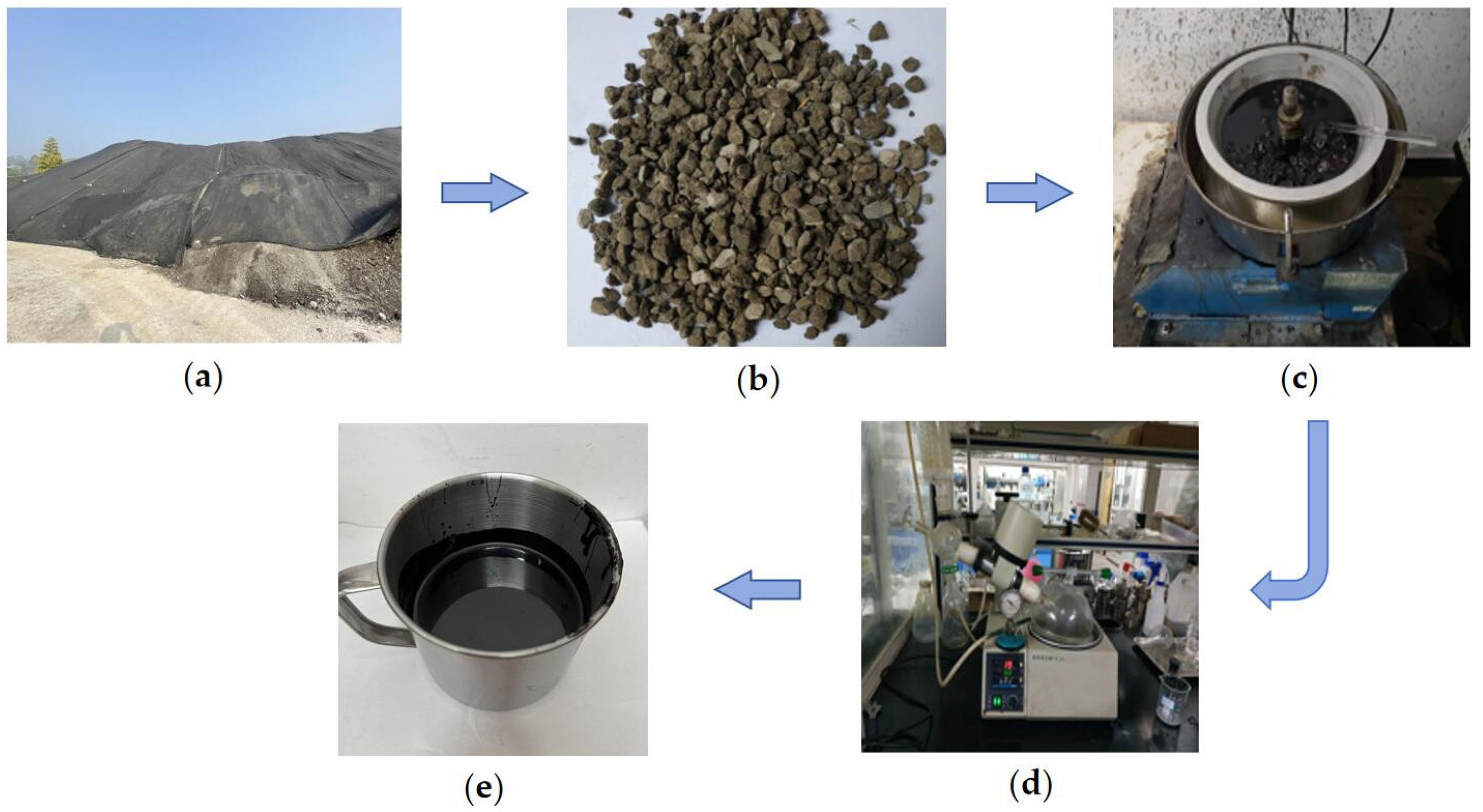
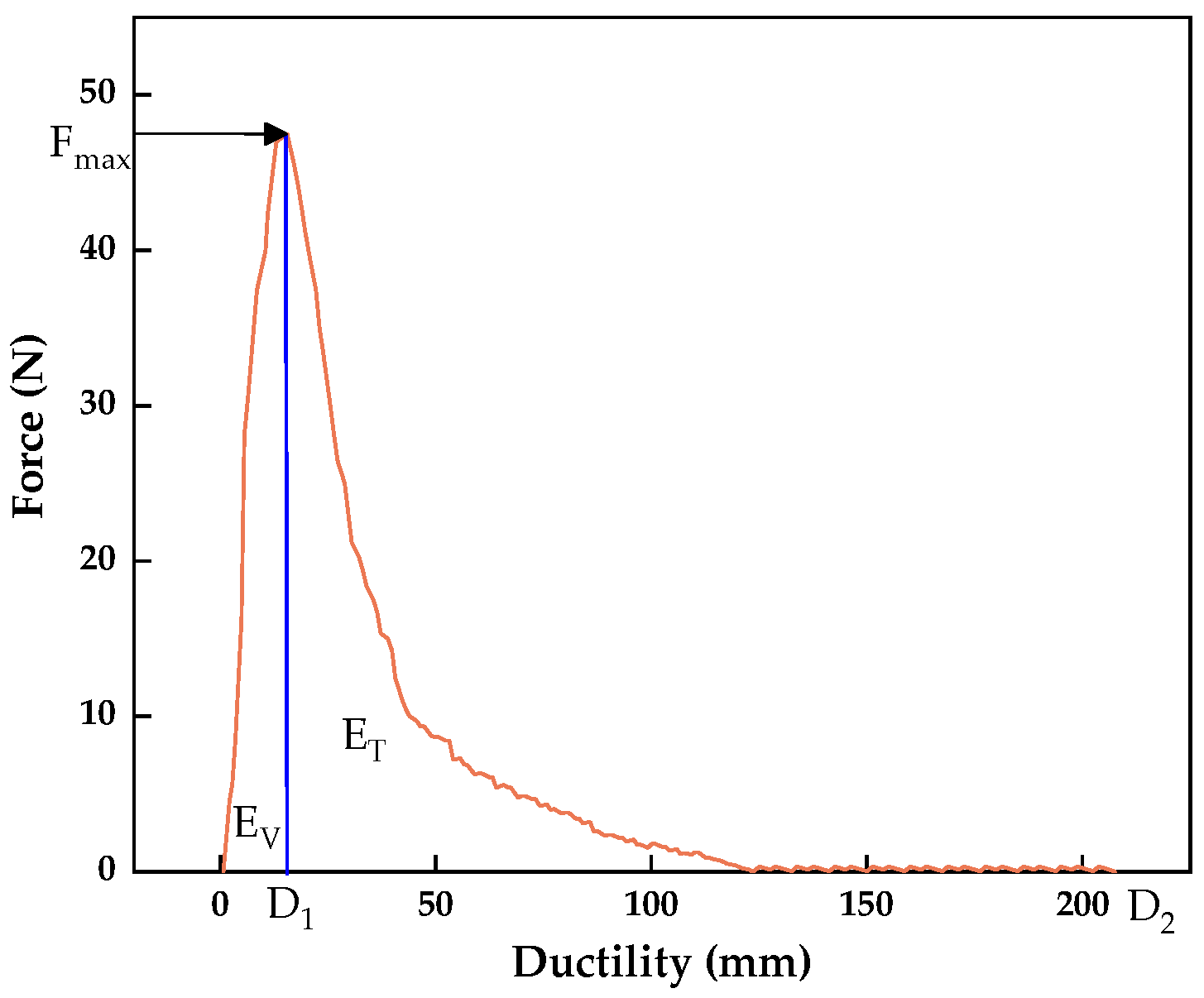

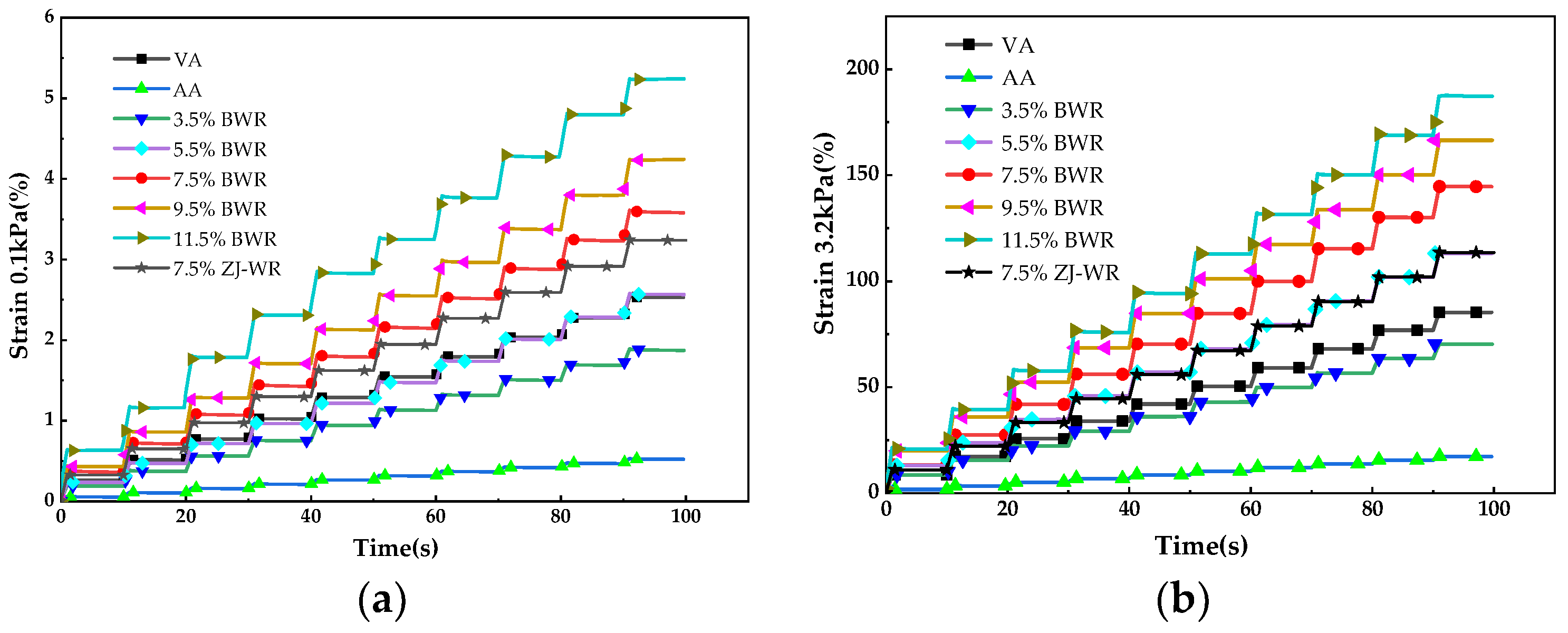
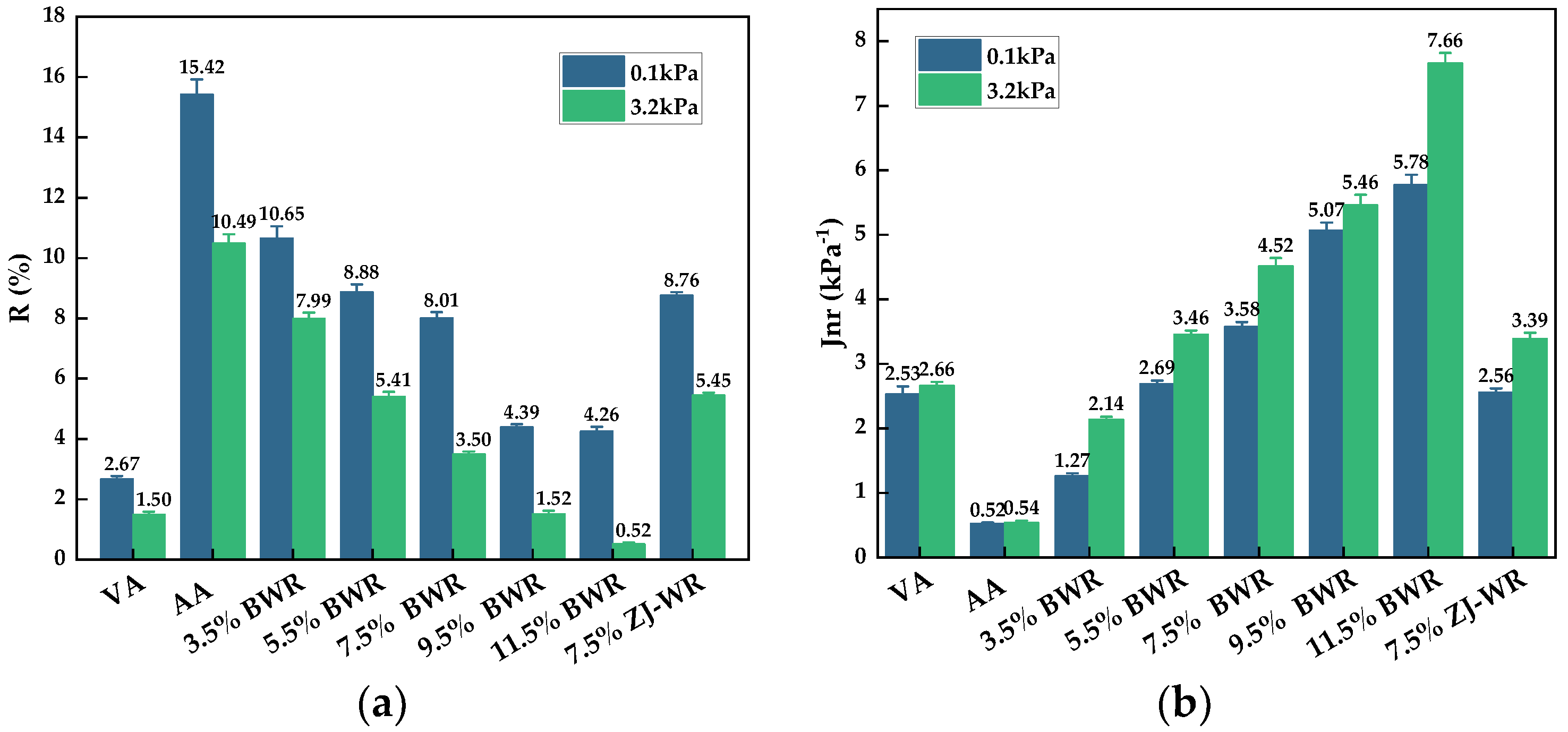






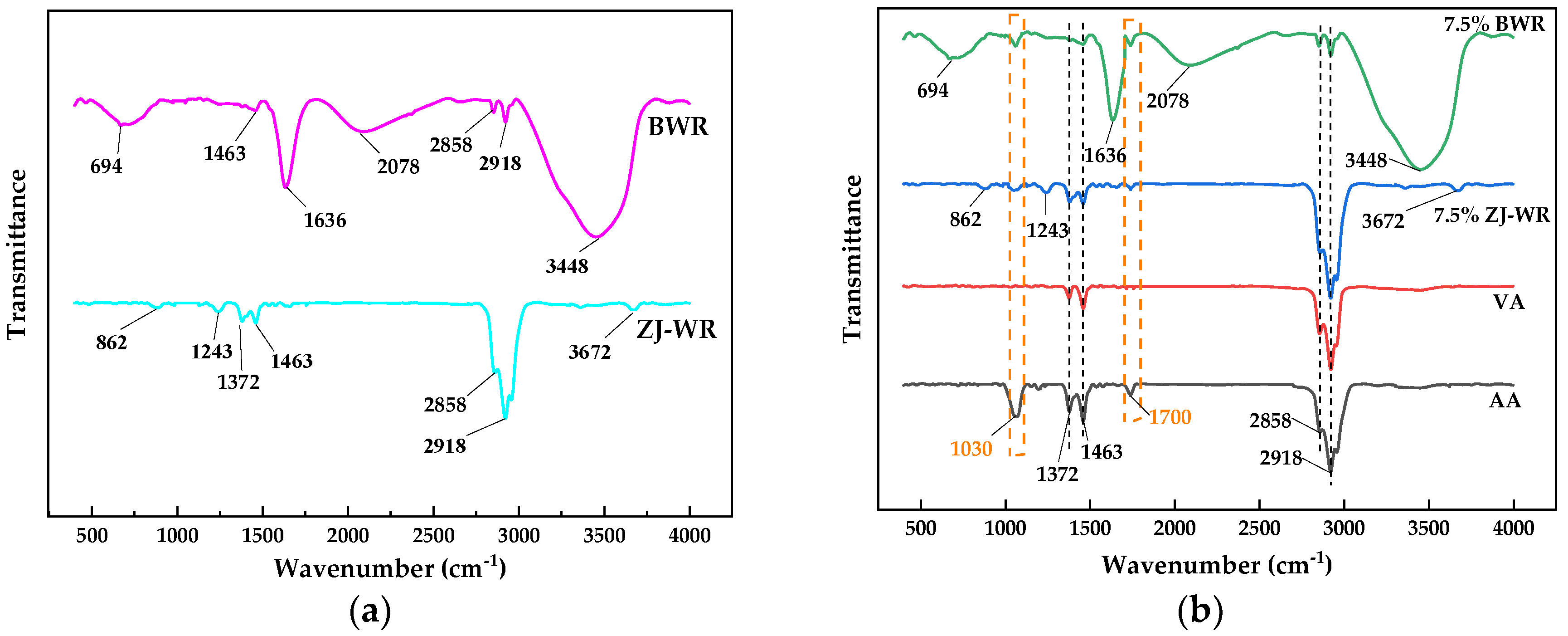
| Properties | BWR | ZJ-WR |
|---|---|---|
| Viscosity, mm2/s (60 °C) | 462 | 589 |
| Flash point, °C | 245 | 270 |
| Viscosity ratio, % (after TFOT, 163 °C) | 1.89 | 1.26 |
| Wt change, % (after TFOT, 163 °C) | 2.36 | 2.7 |
| Density, g/cm3 (25 °C) | 0.89 | 0.92 |
| State | Brown liquid | Yellow solid |
| Type | Penetration (25 °C, 5 s, 100 g)/0.1 mm | Ductility (5 cm/min, 15 °C)/cm | Softening Point/°C | Viscosity (135 °C)/Pa·s |
|---|---|---|---|---|
| RA | 28 | 6.5 | 68.8 | 2.487 |
| AA | 27.6 | 5.3 | 69.1 | 2.674 |
| VA | 74 | 112 | 48.6 | 0.375 |
| 3.5% BWR | 47.5 | 23.2 | 55.9 | 1.029 |
| 5.5% BWR | 62.3 | 69.6 | 53.4 | 0.558 |
| 7.5% BWR | 75.1 | 102.7 | 49.7 | 0.389 |
| 9.5% BWR | 103.7 | 119.2 | 47.4 | 0.301 |
| 11.5% BWR | 128.4 | 128.6 | 44.9 | 0.273 |
| 7.5% ZJ-WR | 77.1 | 98.7 | 50.4 | 0.476 |
| Type | Fmax/N | D1/mm | f/mm·N−1 | EV/N·mm | RT/V |
|---|---|---|---|---|---|
| VA | 47 | 15.5 | 0.33 | 445 | 2.38 |
| 3.5% BWR | 123 | 2.6 | 0.02 | 111 | 0.09 |
| 5.5% BWR | 73 | 10.3 | 0.14 | 554 | 2.13 |
| 7.5% BWR | 50 | 13.0 | 0.26 | 427 | 2.16 |
| 9.5% BWR | 48 | 12.9 | 0.31 | 316 | 2.91 |
| 11.5% BWR | 30 | 10.4 | 0.34 | 238 | 3.54 |
| 7.5% ZJ-WR | 55 | 13.8 | 0.25 | 439 | 2.19 |
| Type | Smax/um2 | Smean/um2 | Stotal/um2 | N |
|---|---|---|---|---|
| VA | 0.37 | 0.084 | 24.2 | 289 |
| AA | 1.13 | 0.095 | 31.7 | 333 |
| 3.5% BWR | 0.53 | 0.075 | 28.3 | 380 |
| 5.5% BWR | 0.78 | 0.083 | 30.4 | 369 |
| 7.5% BWR | 0.86 | 0.109 | 32.2 | 297 |
| 9.5% BWR | 0.73 | 0.087 | 30.6 | 351 |
| 11.5% BWR | 0.67 | 0.085 | 31.0 | 364 |
| 7.5% ZJ-WR | 2.68 | 0.167 | 71.6 | 429 |
| Type | Sa/nm | Sdr/nm2 | SV/nm3 |
|---|---|---|---|
| VA | 1.94 | 4.51 | 0.119 |
| AA | 2.98 | 6.41 | 0.195 |
| 3.5% BWR | 2.09 | 4.77 | 0.140 |
| 5.5% BWR | 2.35 | 5.09 | 0.145 |
| 7.5% BWR | 2.17 | 4.38 | 0.089 |
| 9.5% BWR | 1.86 | 3.86 | 0.073 |
| 11.5% BWR | 2.05 | 4.15 | 0.087 |
| 7.5% ZJ-WR | 1.68 | 3.30 | 0.042 |
| Type | AS=O | AC=O | AC-H |
|---|---|---|---|
| VA | 0.05 | 0.03 | 6.13 |
| AA | 2.97 | 0.58 | 4.07 |
| 7.5% BWR | 0.94 | 0.57 | 7.39 |
| 7.5% ZJ-WR | 0.73 | 0.21 | 5.61 |
Disclaimer/Publisher’s Note: The statements, opinions and data contained in all publications are solely those of the individual author(s) and contributor(s) and not of MDPI and/or the editor(s). MDPI and/or the editor(s) disclaim responsibility for any injury to people or property resulting from any ideas, methods, instructions or products referred to in the content. |
© 2024 by the authors. Licensee MDPI, Basel, Switzerland. This article is an open access article distributed under the terms and conditions of the Creative Commons Attribution (CC BY) license (https://creativecommons.org/licenses/by/4.0/).
Share and Cite
He, Z.; Yu, L.; You, S.; Li, M.; Kong, L.; Wei, D. Regeneration Effect of a New Bio-Based Warm-Mix Rejuvenator on Performance and Micro-Morphology of Aged Asphalt. Materials 2024, 17, 2077. https://doi.org/10.3390/ma17092077
He Z, Yu L, You S, Li M, Kong L, Wei D. Regeneration Effect of a New Bio-Based Warm-Mix Rejuvenator on Performance and Micro-Morphology of Aged Asphalt. Materials. 2024; 17(9):2077. https://doi.org/10.3390/ma17092077
Chicago/Turabian StyleHe, Zhaoyi, Le Yu, Shiyuan You, Maorong Li, Lin Kong, and Dingbang Wei. 2024. "Regeneration Effect of a New Bio-Based Warm-Mix Rejuvenator on Performance and Micro-Morphology of Aged Asphalt" Materials 17, no. 9: 2077. https://doi.org/10.3390/ma17092077
APA StyleHe, Z., Yu, L., You, S., Li, M., Kong, L., & Wei, D. (2024). Regeneration Effect of a New Bio-Based Warm-Mix Rejuvenator on Performance and Micro-Morphology of Aged Asphalt. Materials, 17(9), 2077. https://doi.org/10.3390/ma17092077





